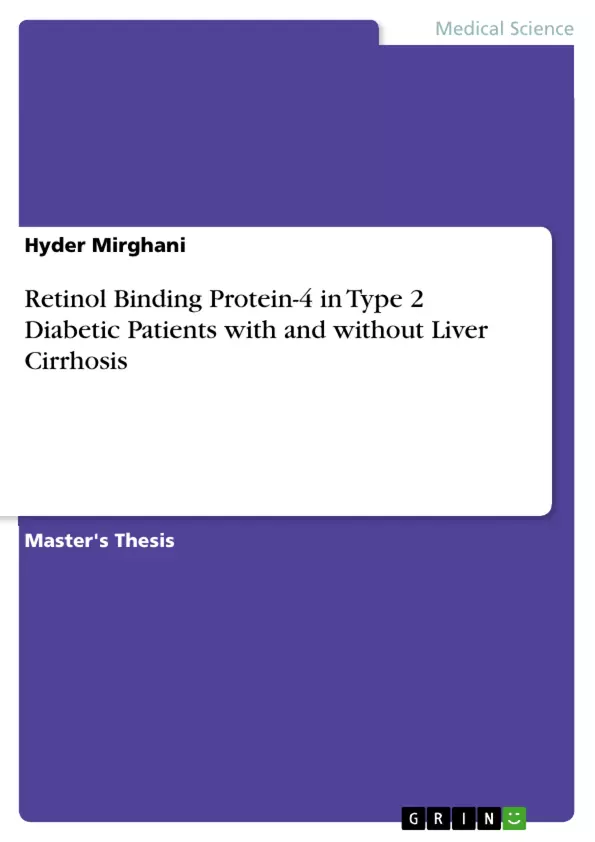The aim of the work is to assess the level of Retinol Binding Protein 4 in type 2 diabetic patients with and without liver cirrhosis.
Diabetes mellitus is a common disease despite the fact that only half or two thirds are diagnosed, the figure is around 189 million people in 2003, and this may reach 324 million by 2025. Diabetes mellitus result from a lack or diminished effectiveness of endogenous insulin. Hyperglycemia is just one aspect of a far reaching metabolic derangement, which may cause serious microvascular and macrovascular complications. Etiological wise diabetes mellitus is classified into type 1, type 2 and other causes, with type 2 accounting for 90% of cases globally.
The prevalence of type 2 diabetes continues to rise at alarming rate, significant defect in glucose homeostasis and fuel metabolism are detectable long before overt diabetes occurs. One of the earliest derangements in metabolism is insulin resistance. It is defined as impaired glucose disposal in a hyperinsulinemic –euglycemic study. Fasting hyperinsulinemia, a compensatory mechanism to maintain euglycemia in setting of insulin resistance, is also present before overt diabetes occurs. Integrated fuel homeostasis relies among interactions among numerous tissues in widely varying states, including the fed state, fasting, and exercise.
This harmony in various tissues is maintained by communication between them, and is signaled by glucose and its various metabolites.
When this communication between tissues (mainly pancreas, adipose tissues, and liver) is lost insulin resistance and diabetes mellitus occurs. Retinol binding protein 4 (RBP4) a 21-KDa protein synthesized in the liver and adipose tissues, formerly recognized for its role as a specific transport for vitamin A, now it is known that it plays a crucial role in insulin resistance and diabetes mellitus. Adipose RBP4 expression and serum RBP4 level are elevated in mouse model of insulin resistance, elevated circulating RBP4 increase blood glucose by inhibiting insulin signaling in skeletal muscle and upregulating hepatic gluconeogenesis.
Frequently asked questions
What is the primary focus of this preview?
This document is a comprehensive language preview intended for academic use, focusing on the analysis of themes within. It includes elements such as the title, table of contents, objectives, key themes, chapter summaries, and keywords related to a specific subject. This preview includes an acknowledgement section, list of abbreviations, and details results, recommendations, and references from study.
What are the chapters in this preview?
The chapters are:\ ListofAbbreviations\ Introduction\ DiabetesMellitus\ Classificationofdiabetesmellitus:\ Diagnosisofdiabetesmellitus:\ Criteriafordiabetesmellitusdiagnosis:\ Prediabetes\ Type2diabetesmellitus:\ Riskfactorsoftype2diabetesmellitus:\ Pathogenesisoftype2diabetes:\ Type2DiabetesMellitusandInsulinResistance:\ KineticofInsulinSecretion\ Mechanismsofglucoseinducedinsulinsecretion:\ Alterationsofinsulinsecretion:\ InsulinActionattheCellularLevel:\ RoleofinsulinsignalingsystemsinInsulinResistance:\ Themetabolicsyndrome\ Type2diabetesmellitusandtheliver \ TheRoleoftheLiverinGlucoseHomeostasis:\ Spectrumofliverdiseaseindiabetics:\ Nonalcoholicfattyliverdiseases(NAFLD)\ PathogenesisofNAFLD\ Diabetesmellitusandhepatocellulacarcinoma:\ Livercirrhosis\ Definition:\ Classificationoflivercirrhosis:\ Retinolbindingprotein4\ Adiposetissueinhealthanddisease \ RetinoidReceptors:\ RetinolBindingProtein4andInsulinResistance:\ Defectsintheabilityoffatcellstotransportglucosearelinkedtoinsulinresistanceinmuscle\ andlivers:\ SubjectsandMethods \ Specimencollectionandpreparation:\ Statisticalanalysis\ Results\ Discussion\ Summary\ Recommendations\ References
What kind of acknowledgements are expressed?
The author expresses gratitude to Allah, Dr. Nehad Shokry Shoeib, Dr. Salwa Seddik Hosny, and Dr. Maram Mohamed Maher Mahdy for their support, guidance, and contributions to the work.
What Abbreviations are in this language preview?
The list of abbreviations are:\ ADAG\ ALB\ ALT\ AST\ ATP\ BMI\ CGM\ CHOL\ CVD\ DCCT\ DM\ DPP\ DSME\ FPG\ GDM\ HAPO\ HbA1c\ HCV\ HDL\ HNF\ IDDM\ IFC\ IFG\ IGT\ IRSI\ LADA\ LDL\ MODY\ NAFLD\ NASH\ NGSP\ NHANES\ OGTT\ PPG\ PT\ RBP4\ SMBG\ TG\ UKPDS
- Citar trabajo
- Hyder Mirghani (Autor), 2017, Retinol Binding Protein-4 in Type 2 Diabetic Patients with and without Liver Cirrhosis, Múnich, GRIN Verlag, https://www.grin.com/document/385499



